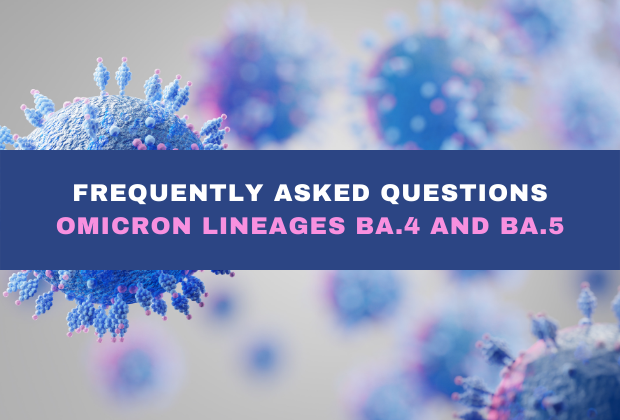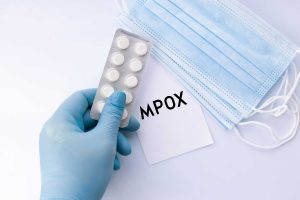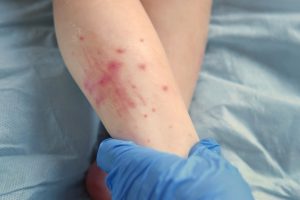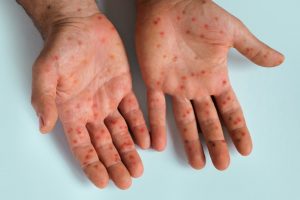1. What are BA.4 and BA.5?
BA.4 and BA.5 are two newly-designated Omicron lineages. They are currently still classified as the Omicron variant, meaning that they are not a new Variant of Concern (VOC); rather, they are Omicron viruses with a new combination of mutations. In terms of their mutations, BA.4 and BA.5 share mutations across their genomes with both BA.1 and BA.2 (also lineages of Omicron), but are most similar to BA.2. However, within spike, relative to BA.2, they possess the additional mutations: 69-70 deletion (causing S-gene target failure on the Thermo Fisher Scientific TaqPath COVID-19 PCR test, initially used as a proxy for BA.1), L452R (previously seen in Kappa, Delta, Epsilon variants), F486V, and R493 (i.e., no mutation at this position). BA.4 and BA.5 differ from one another in mutations that are outside of the spike gene but they are identical to each other in terms of spike mutations (1,2). For this reason, they are often discussed together.
2. Where have BA.4 and BA.5 lineages been detected?
The Omicron lineage BA.4 was first detected from a specimen collected on 10 January 2022 in Limpopo. As of 29 April 2022, BA.4 has been detected in all provinces. The percentage of sequences designated BA.4 has grown from <1% in January 2022 to > 35% in April 2022 (3).
The Omicron lineage BA.5 was first detected from a specimen collected on 25 February 2022 in KwaZulu-Natal. As of 22 April 2022, BA.5 has been detected in Gauteng, Limpopo, Mpumalanga, KwaZulu-Natal, the North West, and the Western Cape. The percentage of sequences designated BA.5 has increased from <1% in January 2022 to 20% in April 2022 (3).
Collectively, the percentage of sequences assigned to BA.4 and BA.5 have increased from <1% in January 2022 to >50% in April 2022 (3). Both lineages have been detected in countries outside South Africa, such as the USA, UK, and Botswana. These lineages are being closely monitored and data are being uploaded regularly. Weekly updates regarding SARS-CoV-2 in South Africa can be found at https://www.nicd.ac.za/diseases-a-z-index/disease-index-covid-19/surveillance-reports/.
3. Is it unusual to detect a new Omicron lineage?
It is not unusual to detect new Omicron lineages. As SARS-CoV-2 continues to spread, it continues to evolve and gain mutations. When a group of genomes all contain the same set of mutations, they are designated as a new lineage. There are many lineages of Omicron (4). While BA.4 and BA.5 are new Omicron lineages, they do not represent a new SARS-CoV-2 variant and are currently still classified as Omicron.
4. Is it possible that BA.4/BA.5 will replace Omicron in SA?
Omicron has been the dominant variant in South African since it emerged in November 2021. Initially, BA.1 was the dominant lineage, and remained dominant through January 2022. Omicron BA.2 started increasing in proportion in December 2021 and was dominant by February 2022. Omicron BA.3 never became dominant, but has been continually detected a low levels (3). BA.4 and BA.5 are still classified as lineages of the Omicron variant, and so if they become dominant, Omicron will still be the dominant variant in South Africa. BA.4 and BA.5 have increased in prevalence in SA, and as of 29 April 2022, together make up the majority of genomes.
5. Have there been any concerning new symptoms with BA.4/BA.5?
As of 29 April 2022, there are currently a relatively small number of BA.4 and BA.5 cases and so it is too early to definitively know if there are any new symptoms associated with these lineages. However, given that the lineages are still classified as Omicron, and that the majority of mutations (particularly within the spike protein) are the same, it is likely that symptoms will be similar.
6. Could the emergence of BA.4/BA.5 lineages result in an increase in COVID-19 cases in South Africa?
As the BA.4 and BA.5 lineages have some different mutations to other Omicron lineages it is possible that there may be some immune escape leading to an increase in the number of COVID-19 cases. However, South Africa has a high immunity due to previous infection and vaccination, which has been shown to protect against the risk of developing severe COVID-19 disease (5, 6, 7). There is currently no indication that this will change with BA.4/BA.5, however the situation will continue to be monitored closely.
7. Will current COVID-19 vaccines still work for BA.4 and BA.5?
Vaccination remains effective at preventing severe disease, and individuals are strongly encouraged to be vaccinated and receive appropriate booster doses according to the latest COVID-19 vaccination recommendations.
Authors: Josie Everatt, Daniel G. Amoako, Dikeledi Kekana, Jocelyn Moyes, Mignon du Plessis, Sibongile Walaza, Nicole Wolter, Anne von Gottberg, Cheryl Cohen
Centre for Respiratory Diseases and Meningitis (CRDM), National Institute for Communicable Diseases (NICD) of the National Health Laboratory Service (NHLS), Johannesburg, South Africa
References
- Tegally et al., “Continued Emergence and Evolution of Omicron in South Africa: New BA.4 and BA.5 lineages”. 2022. https://krisp.org.za/manuscripts/MEDRXIV-2022-274406v1-deOliveira.pdf
- UKHSA, SARS-CoV-2 variants of concern and variants under investigation in England, Technical briefing 40. 8 April 2022, accessed 29 April 2022 at https://assets.publishing.service.gov.uk/government/uploads/system/uploads/attachment_data/file/1067672/Technical-Briefing-40-8April2022.pdf
- https://www.nicd.ac.za/wp-content/uploads/2022/04/Update-of-SA-sequencing-data-from-GISAID-29-Apr-2022.pdf
- https://www.pango.network/summary-of-designated-omicron-lineages/
- Wolter, et al. “Early assessment of the clinical severity of the SARS-CoV-2 omicron variant in South Africa: a data linkage study.” The Lancet vol. 399,10323 (2022): 437-446. doi:10.1016/S0140-6736(22)00017-4
- Madhi, et al. “Population Immunity and Covid-19 Severity with Omicron Variant in South Africa.” The New England Journal of Medicine vol. 386,14 (2022): 1314-1326. doi:10.1056/NEJMoa2119658
- Kleynhans, et al. “SARS-CoV-2 Seroprevalence after Third Wave of Infections, South Africa.” Emerging Infectious Diseases vol. 28,5 (2022): 1055-1058. doi:10.3201/eid2805.220278





